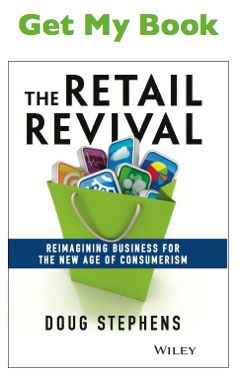By Doug Stephens

In the old age of business the goal for most companies was continuous improvement. The idea was to keep the engines of innovation slowly and steadily humming along, improving what the company did a little more with each passing day. Typically, improvement was both incremental and vertically benchmarked –measured almost entirely against in-category competitors. And for centuries, that worked just fine, because, in the old era, your competitors were known, visible and familiar to you. You went to the same industry conferences, award ceremonies and chamber of commerce meetings together. You got nice, neat market research data showing where you stood relative to that known competitive set. And if some outsider did have the balls to try to scale the walls of your industry it was often simply impossible – requiring epic amounts of capital and infrastructure just to get started. In other words, competing was viable, because you could see the competition and new competition was rare.
Today, none of these comfortable conditions or conformities apply.
The reality today is that the industries being radically disrupted aren’t being rocked by known competitors at all but by complete outsiders. And we’re not talking about pushover industries either. Once seemingly impenetrable verticals such as the payments, optical sales and hotel industries, are all being disrupted by outsiders. Web developer and Twitter founder Jack Dorsey’s unconventional payment platform Square, is now processing in excess of ten billion dollars in payments per year. Online prescription eyewear retailer Warby Parker has grown over 500 percent since its founding in 2010, by then-full-time Wharton students Neil Blumenthal, Andrew Hunt, Jeffrey Raider and David Gilboa. And peer-to-peer accommodation rental network airbnb, founded by friends and design school alumni Joe Gebbia, Brian Chesky, and Nathan Blecharczyk, in 2007 recently passed the 10 million nights-booked milestone. Not too shabby for a bunch of industry newbies.
But each of these startups began out of a very simple premise – that current industry alternatives sucked and that there had to be a better, more consumer friendly way. They weren’t shackled by the historic constraints and limitations of their categories. They didn’t aim to be marginally better than the competitor down the street and they weren’t guided by any sort of Marquess of Queensberry rule book for their industry. They simply imagined a different reality.
And this is precisely why evolution and continuous improvement is no longer a viable survival strategy.
In a post industrial, post Internet, post mobile world, there’s a good chance that the corporate DNA that got you this far is the very thing that will kill you in the end. Somehow, you need to start thinking like an outsider because somewhere there’s a 22-year-old kid working on something in his/her parents basement aimed at eradicating your company – maybe your whole industry.
So, reimagination is absolutely the only strategic alternative. You need to find, hire and nurture outsiders who come free of the blinders of industry bias, who can deliver the clarity needed to completely re-think what you do. To throw away any paradigms you have about the way your industry works. To not defend the deficiencies of your current model but rather reinvent it. Think about it… if we were starting from scratch, would we structure the retail insurance industry the way it is? How about the airline industry? The mobile telco industry? You get the point.
Your competitor isn’t who you think it is. They’re not at the conferences you  attend. They don’t turn up in your competitive analysis. They don’t play by your rules. They only know that what you do can be done much better. It comes down to this; in order to survive, you need to disrupt your own business model. You need to be the one who figures out how to put you out of business. The only alternative is to wait and let someone do it for you and simply read about your own sudden irrelevance in the New York Times.
attend. They don’t turn up in your competitive analysis. They don’t play by your rules. They only know that what you do can be done much better. It comes down to this; in order to survive, you need to disrupt your own business model. You need to be the one who figures out how to put you out of business. The only alternative is to wait and let someone do it for you and simply read about your own sudden irrelevance in the New York Times.

